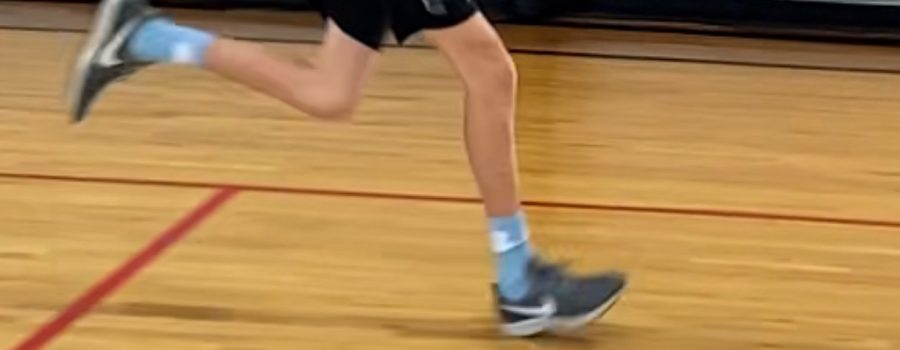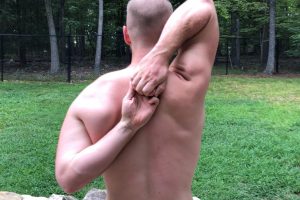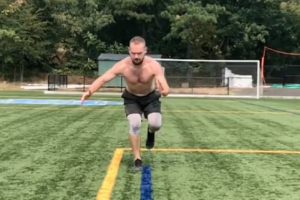Podcast #27 – Stop Heel Striking
The first thing that is important to understand is the context for track and cross country. These are their own sports, NOT just supplemental training. Unless the energy system and timing of the event is similar, training to get better at these sports will likely have no cross over to any other sport.
Cross country is long, steady distance training. This stands in contrast to the context of almost every other team sport that focuses on high intensity, short duration effort. You can train to be aerobically fit with a high aerobic threshold and a majority of type 1 muscle fibers OR you can train to be explosive, powerful, and quick with a majority of type 2 muscle fibers. It’s not that simple, of course, but the main focus needs to be on the fact that “doing cross country” is not going to keep you in shape for tennis or make you a better tennis player. In fact, it’s likely to have the opposite effect.
With that said, if you want to make running your primary sport, then by all means, go for it! I ran track and cross country for years as a scholastic athlete and was much better for it. All I am concerned with is the transparency and understanding that these sports are not inherently beneficial when it comes to athletic development!
If you are an athlete with aspirations outside of running sports, my recommendation is to pursue track with a focus on short to mid distance running (100-800 meters). This is because there is a much higher emphasis placed on correct form and running mechanics for these athletes than there is with the long-distance runners. The more power, speed, and performance you demand from your body, the less room for error you can have.
Running is a skill. It requires strength, control, balance, coordination, and a high pain tolerance. Anyone can go out for a run, all you need is a pair of shoes and a bit of space. That’s why running is considered as a ubiquitous mark of health and fitness because it is accessible by everyone. Unfortunately, this also creates a problem. Just because you can go run, doesn’t mean you have the ability to run well. Without a focus and practice of proper technique, a solid foundation of strength, and a base of movement specific conditioning, many people run themselves straight into injury. Pun intended.
As bipedal mammals (moving on two feet instead of four) there are two different types of movement patterns available to us: walking and running. The difference is the introduction of flight phase, or time spent in the air. When we walk, we always have one foot on the ground. As you step from side to side you are just shifting your weight from one foot to the other. This is an amazing achievement for a mammal. Most animals have 4 legs and cannot stand upright for long periods of time as a result. Since we can move on two limbs, we are able to use our arms to work with tools and hold things! And you can thank your heels for this. The ability to heel strike and maintain a balance as we step walk with a long ground contact time allows us to cover long periods of distance steadily. We sacrifice a great deal of speed and running velocity by being bipedal movers, just go race a horse or dog and tell me how it goes.
But the moment we transition into a jog, no matter how slow, we introduce flight into our stride. This means we are jumping from one foot to the other. This new move requires a new movement pattern – the fore foot strike. To help you visualize this, imagine you are jumping rope, with no shoes. You’re jumping on the front of your foot, right? Now shift to jumping on your heels. Not as easy and pretty painful… Our ankles, calves, and Achilles’ heel are designed to work as shock absorbers for our strides. This allows us to land softly, absorb force, and reproduce is effectively hundreds and thousands of times in a row without injury.
Additionally, we have pronation. Although much maligned by common marketing, pronation is a compeletely natural and beneficial aspect of running and movement. Just as parkour athletes roll when landing from a big jump to dissipate force, our foot naturally rolls and splays across a multitude of bones to spread out force from impact.
Unfortunately, even in the face of a large body of evidence both empirical and data driven evidence, people continue to accept heel striking as a proper form of running. But just because you can do something, and do it for a long period of time, does not mean that it’s ideal or healthy. You can drive on a flat time for a while, but that doesn’t mean it’s best for the car!
When we heel strike, or land with our heels first, we remove all of these benefits and direct the force of impact straight to the knee. This is problematic and results in everything from overuse injuries to the joints and ligaments in the legs and muscle strains from improper loading. Of course, heel striking isn’t possible without the modern day shoe and it’s 1 inch or thicker foam padding and raised heel. These shoes are designed to put the foot in a “correct” position upon landing, but end up allowing for, and encouraging, sloppy and injurious running form.
Much like the modern day office chairs promise ergonomic features and gimmicks to reduce back pain, today’s shoes promise stability, performance, and safety. But just like back pain hasn’t been fixed by improving chair technology, poor running and leg injuries aren’t going to be fixed by more shoe technology.
The vast majority of footwear today is built around aesthetic and marketing. I’d love for you to explain the difference between a running shoe, a training shoe, a tennis shoe, and a walking shoe. We’ve been lead to believe for decades now that the next jump in performance and fix to that foot pain is in the shoes. We’ve been sold pronation control shoes, insoles, stability shoes, and ankle support shoes that should have fixed our problems. But I don’t see the incidence of foot pain and overuse injury getting any better, do you?
The simple fact is that there is no shoe that can do for our feet what our feet should be able to do for themselves. In reaction to the super minimalist shoes I wear, people as me “But what about the support? How do you move? You run in those too??” Your feet have built in support through a beautifully designed arch, that is a composition of fascia, muscle, and bone. You just have to put in the work to develop it.
Now, I am not suggesting that shoes do not provide benefit! I wear shoes every day and am super grateful when I don’t cut my foot or step on a rock! I am saying that the industry has gotten carried away and people have fallen for the simple fix that’s too good to be true. When it comes to your feet and shoes, we’ve gotten it backwards. The shoe should be made for the foot, not the other way around! This means that the shoe should be a tool that works with your foot to improve function and strength, not a cast that impedes movement.
So, the takeaway for you at this point are these two things: You need to set yourself up for success by choosing shoes that allow your feet to move naturally, and you have to put in the work to develop the skill and strength required to be a good runner.




